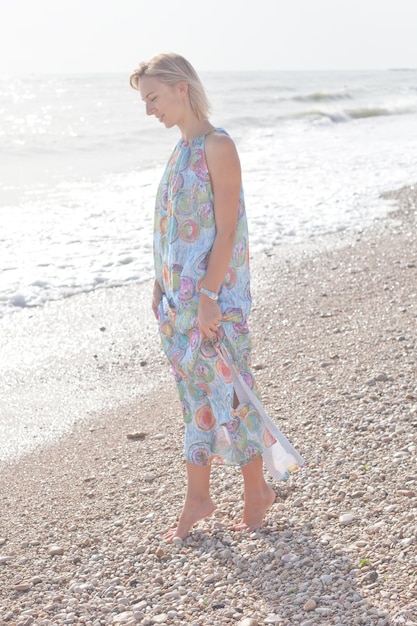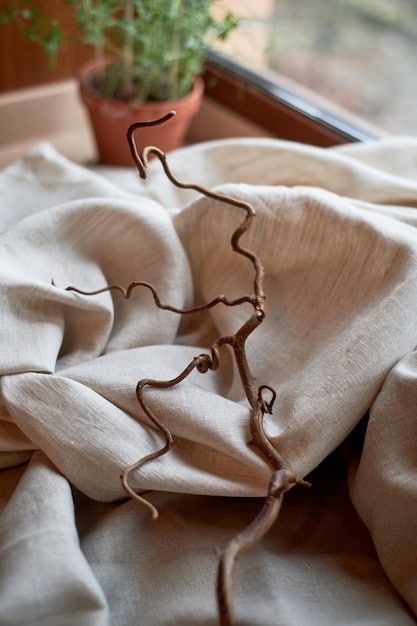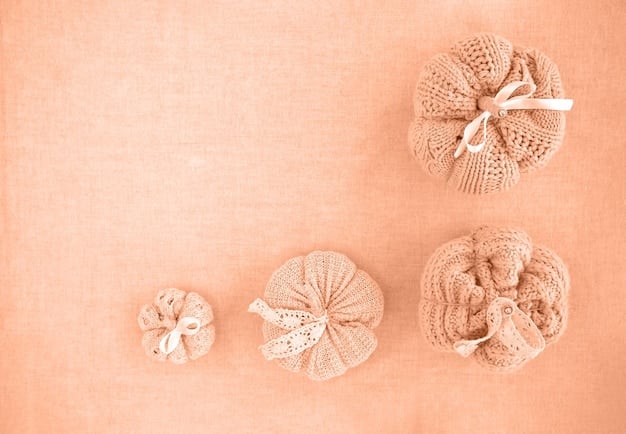Beat the Heat: 5 Breathable Fabrics for Summer Wardrobe 2025

To effectively Beat the Heat: 5 Breathable Fabrics Every Summer Wardrobe Needs in 2025, consider materials like linen, cotton, modal, rayon, and Tencel, which offer superior breathability and moisture-wicking properties, ensuring comfort and style even in the most intense summer temperatures.
As temperatures rise and days lengthen, the quest for comfort without compromising style becomes paramount. Choosing the right fabrics is crucial to successfully navigating the summer heat, transforming your wardrobe from merely functional to a sanctuary of coolness. The following insights delve into innovative yet classic fabric choices that promise to redefine your seasonal dressing in 2025.
The Science of Summer Comfort: Why Fabric Matters
The foundation of a comfortable summer wardrobe lies not just in aesthetic appeal but profoundly in the textiles themselves. Understanding how different fibers interact with heat and moisture is key to making informed choices that genuinely enhance your well-being during warmer months. This section explores the fundamental principles behind breathable fabrics and their undeniable importance.
The human body’s primary mechanism for cooling is perspiration. When sweat evaporates from the skin, it dissipates heat, lowering our core temperature. However, if clothing traps moisture, this evaporative process is hindered, leading to discomfort, stickiness, and even heat-related issues. Breathable fabrics are designed to facilitate this process, allowing air to circulate freely and moisture to escape.
Understanding Fabric Properties
Different fabric weaves and compositions inherently possess varying degrees of breathability and absorption. Natural fibers, for instance, often excel in these areas due to their unique cellular structures. Synthetic materials, while sometimes engineered for performance, can occasionally trap heat if not specifically designed for warm weather.
- Moisture-Wicking: The ability of a fabric to draw moisture away from the skin and quickly spread it across its surface for faster evaporation.
- Air Permeability: How easily air can pass through the fabric, directly impacting its ability to dissipate heat.
- Thermal Conductivity: Fabrics with high thermal conductivity can transfer heat away from the body more efficiently.
Ultimately, selecting the right fabric is about optimizing these properties to create an environment around your body that encourages cooling and prevents overheating. It’s a blend of science and style, leading to a truly comfortable summer experience.
Choosing the right fabric for summer goes beyond just looking good; it’s about optimizing your personal microclimate. The interplay of fabric properties like moisture-wicking and air permeability dictates how well your clothing can help regulate body temperature, making a significant difference in comfort during hot weather.
Linen: The Unrivaled King of Cool
Linen has long been celebrated as the quintessential summer fabric, and for good reason. Its natural properties make it exceptionally suited for hot, humid conditions, offering a blend of elegance and unparalleled comfort. In 2025, linen continues its reign, evolving with new blends and finishes that maintain its core benefits while enhancing wearability.
Derived from the flax plant, linen fibers are thicker and more rigid than cotton, giving the fabric its characteristic texture and natural crease. While some perceive its tendency to wrinkle as a drawback, many embrace it as part of linen’s relaxed, sophisticated charm. This natural creasing is also a testament to its authenticity and purity.
Why Linen Excels
Its unique structure allows for remarkable air circulation, making it highly breathable. Linen’s fibers are hollow, acting as natural conductors that wick away moisture and allow it to evaporate quickly, providing a cooling sensation against the skin.
- Exceptional Breathability: Its loosely woven structure and natural fiber properties ensure maximum airflow.
- Highly Absorbent: Can absorb up to 20% of its weight in moisture before feeling damp, then dries quickly.
- Natural Hypoallergenic: Ideal for sensitive skin as it resists bacteria and fungi.
- Durability: Stronger than cotton fibers, linen becomes softer and more lustrous with each wash and wear.
In 2025, designers are incorporating linen into a wider array of garments, from structured blazers and trousers to voluminous dresses and tailored shorts. Blends with cotton or rayon are also becoming popular, offering a slightly smoother drape and reduced wrinkling while retaining much of linen’s breathability. This makes linen an indispensable part of any summer wardrobe.
Linen remains the top choice for summer owing to its remarkable ability to keep you cool and dry. Its natural fibers are not only highly breathable but also incredibly absorbent, ensuring comfort and a chic, relaxed aesthetic that only improves with wear. Its versatility and inherent elegance solidify its status as a summer essential.

Cotton: The Versatile and Familiar Staple
Cotton has been a wardrobe mainstay for centuries, lauded for its softness, versatility, and everyday comfort. When it comes to beating the summer heat, cotton remains a reliable choice, especially in lighter weaves and blends. Its widespread availability and affordability make it an accessible option for everyone building a heat-beating wardrobe in 2025.
As a natural fiber derived from the cotton plant, it is inherently breathable and absorbent. These qualities make it comfortable against the skin, especially for casual wear, t-shirts, and everyday essentials. However, not all cotton is created equal, particularly when considering its performance in hot weather.
Optimizing Cotton for Summer
The key to maximizing cotton’s benefits in summer lies in choosing the right weave and weight. Lightweight cottons like voile, seersucker, and poplin are far more breathable than heavier denim or flannel. Organic cotton also offers environmental benefits and often feels softer against the skin.
- Poplin: A tightly woven, plain weave fabric that is smooth, crisp, and provides good airflow.
- Seersucker: Characterized by its puckered texture, which creates small air pockets, keeping the fabric away from the skin for better ventilation.
- Voile: A sheer, lightweight fabric with a high thread count, offering a delicate drape and excellent breathability.
While cotton absorbs moisture well, it can also hold onto it, making it slow to dry compared to linen or some synthetics. For very intense humidity or active wear, blended fabrics might be a better choice. Nonetheless, for most summer activities and daily wear, cotton items like crisp shirts, soft dresses, and comfortable shorts are indispensable. Its natural feel and ease of care continue to make it a globally favored textile.
Cotton’s enduring appeal in summer stems from its natural breathability and softness, making it a comfortable option for daily wear. Choosing lighter weaves like poplin or seersucker enhances its cooling properties, offering a versatile and familiar fabric solution to tackle warmer temperatures with ease.
Modal and Rayon: The Soft Sisters of Breathability
Modal and rayon, both semi-synthetic fibers derived from regenerated cellulose, offer an intriguing combination of luxurious softness and excellent breathability, making them increasingly popular choices for summer wardrobes in 2025. While often grouped together due to their similar origins and properties, they each possess distinct characteristics.
Rayon, invented in the late 19th century as an artificial silk, is made from wood pulp. It has a beautiful drape and a silky feel, making it a versatile fabric for both casual and more formal summer attire. Modal, a type of rayon, is produced using a slightly different process, typically from beechwood pulp, resulting in an even softer, more stable fiber that resists shrinking and fading.
Why They Are Summer Superstars
Both modal and rayon excel in moisture absorption, often surpassing cotton in this regard. Their smooth surfaces feel cool against the skin and prevent stickiness, even in high humidity. Their lightweight nature and graceful drape also contribute to a breezy, comfortable feel.
- Exceptional Softness: Both fabrics are incredibly soft to the touch, feeling luxurious against the skin.
- Superior Moisture Absorption: They wick moisture away from the body efficiently, helping to keep you dry.
- Beautiful Drape: Their flowing nature makes them ideal for summer dresses, loose trousers, and blouses.
- Resistance to Wrinkling: Compared to linen, they wrinkle less, offering a more polished look with less effort.
While these fabrics are comfortable, it’s important to note that their wet strength can sometimes be lower than cotton or linen, so care should be taken during washing. Despite this, their combination of comfort, elegance, and breathability makes modal and rayon essential considerations for a comfortable and stylish summer. Their versatility allows them to transition seamlessly from daytime casual wear to evening elegance, making them valuable additions to any warm-weather ensemble.
Modal and rayon are celebrated for their silky softness and excellent moisture-wicking capabilities, providing a luxurious yet breathable option for summer garments. Their beautiful drape and resistance to wrinkling offer both comfort and effortless elegance, making them ideal for a range of styles in warmer climates.
Tencel Lyocell: The Sustainable Game-Changer
Tencel Lyocell, a brand of lyocell fiber produced by Lenzing AG, has emerged as a frontrunner in sustainable and highly functional textiles. Its eco-friendly production process combined with superior performance attributes makes it an increasingly relevant and sought-after fabric for summer wardrobes in 2025. For the conscious consumer seeking both comfort and responsibility, Tencel presents an compelling option.
Tencel Lyocell is derived from sustainably sourced wood pulp, primarily eucalyptus. Its closed-loop production process minimizes environmental impact by recovering and reusing solvents, distinguishing it from other regenerated cellulosic fibers. This commitment to sustainability doesn’t compromise its performance, making it a true innovator in the textile industry.
The Tencel Advantage
Beyond its environmental credentials, Tencel Lyocell’s physical properties are perfectly suited for hot weather. It is known for its incredible softness, often compared to silk, and its excellent moisture management capabilities.
- Enhanced Breathability: Its microscopic fibrils are structured to regulate temperature and allow for optimal air permeability.
- Superior Moisture Wicking: Efficiently draws moisture away from the skin, keeping you dry and preventing bacterial growth.
- Gentle on Skin: Exceptionally smooth fiber surface, ideal for sensitive skin, and prevents irritation.
- Durability and Color Retention: Stronger than cotton when wet and maintains vibrant colors wash after wash.
Tencel’s versatility allows it to be blended with other fibers like cotton, linen, or wool to enhance their properties, adding softness, drape, and moisture-wicking capabilities. From casual wear to activewear and even sophisticated dresses, Tencel Lyocell is proving to be a revolutionary fabric for those aiming to stay cool, comfortable, and environmentally conscious during the summer months. Its widespread adoption indicates a shift towards more sustainable and high-performance material choices.
Tencel Lyocell stands out as a sustainable and high-performing fabric, offering exceptional breathability and moisture-wicking for summer. Its silky feel and environmentally friendly production process make it an ideal choice for consumers seeking comfort, durability, and a conscious approach to their wardrobe in 2025.
Choosing Your Perfect Summer Fabric Blend
While individual fabrics possess distinct advantages, the future of summer clothing in 2025 lies increasingly in innovative blends. Combining different fibers can create textiles that capitalize on the strengths of each component, resulting in garments that offer enhanced comfort, durability, and stylistic versatility. Understanding these blends is crucial for building a truly intuitive and adaptable summer wardrobe.
The goal of blending is often to mitigate the drawbacks of a single fiber while amplifying its benefits. For example, linen’s tendency to wrinkle can be lessened when blended with cotton or modal, which also introduce additional softness. Similarly, adding a small percentage of a synthetic like elastane to natural fibers can provide stretch and improved shape retention without compromising breathability.
Popular and Effective Blends for Summer
Several combinations are proving exceptionally effective at delivering the ultimate warm-weather experience:
- Linen-Cotton Blends: Offer the relaxed elegance of linen with the softness and reduced wrinkling of cotton. They are highly breathable and comfortable for everyday wear.
- Modal-Cotton Blends: Combine the superb softness and moisture absorption of modal with cotton’s familiarity and stability. Ideal for t-shirts, loungewear, and flowy dresses.
- Tencel-Linen Blends: Marry Tencel’s sustainable credentials and smooth feel with linen’s crisp texture and superior airflow, creating luxurious yet practical garments.
These blends allow for a broader range of garment types, from sharp tailored pieces that remain comfortable in the heat to soft, fluid leisurewear. When examining fabric labels, look beyond just the primary fiber. The blend composition can significantly impact how a garment feels, performs, and looks throughout the summer. Experimenting with these innovative blends will ensure your wardrobe is not only stylish but also remarkably comfortable, adapting seamlessly to varying summer conditions and preferences.
The optimal summer wardrobe often features strategic fabric blends engineered to enhance comfort and performance. Combining materials like linen, cotton, modal, and Tencel allows for tailored solutions that offer superior breathability, moisture management, and reduced wrinkling, adapting to diverse summer needs and styles.

Caring for Your Breathable Summer Fabrics
Maintaining the integrity and breathability of your summer fabrics is just as important as selecting them. Proper care ensures longevity, preserves their unique properties, and keeps them looking fresh and feeling comfortable season after season. Different fibers and blends often require specific attention, making a general understanding of textile care essential for a well-kept wardrobe in 2025.
Ignoring care instructions can lead to shrinking, stretching, fading, or diminished performance, particularly with delicate natural and semi-synthetic fibers. Always check the care label on each garment, as it provides the most accurate instructions from the manufacturer. However, some general guidelines can help extend the life of your breathable summer clothing.
Key Care Tips for Longevity
Most breathable summer fabrics benefit from gentle washing and drying techniques to preserve their structure and feel.
- Use Cool Water: Washing in cool or lukewarm water helps prevent shrinking and fading, especially for linen, rayon, and Tencel.
- Gentle Cycle: A delicate or gentle wash cycle reduces stress on the fibers, keeping them soft and retaining their shape.
- Mild Detergent: Avoid harsh detergents, which can strip natural fibers of their softness or damage their structure.
- Air Drying: Whenever possible, air dry your summer garments. Hang them or lay them flat to prevent heat damage, excessive wrinkling, and reduce energy consumption. If using a dryer, opt for a low heat setting.
- Ironing (if necessary): Iron linen and cotton while still slightly damp to ease wrinkles. Rayon and Tencel often require less ironing, or can be steamed.
By adopting these conscious care practices, you can ensure that your breathable summer fabrics continue to provide maximum comfort and style. Investing a little extra time in care pays dividends in the form of clothing that feels and looks great throughout the warm months, embodying both style and sustainability.
Proper care is paramount for preserving the breathability and longevity of your summer fabrics. Gentle washing with cool water, utilizing mild detergents, and opting for air drying are key practices. These simple steps ensure your garments retain their unique properties, keeping you comfortable and stylish through countless summers.
| Key Fabric | Brief Description |
|---|---|
| 🌬️ Linen | Highly breathable, absorbent, and known for its quick-drying properties. |
| ☁️ Cotton | Soft, versatile, and breathable in lighter weaves like seersucker and poplin. |
| silky Modal & Rayon | Luxuriously soft, excellent moisture absorption, and beautiful drape. |
| 🌿 Tencel Lyocell | Sustainable, superb breathability, moisture-wicking, and silky smooth feel. |
Frequently Asked Questions
▼
Fabric choice is crucial for summer comfort because it directly impacts how your body regulates temperature. Breathable fabrics allow heat and moisture to escape, preventing overheating and stickiness. Choosing the right material can enhance airflow and moisture-wicking, making a significant difference in your physical comfort during hot weather conditions.
▼
Linen is ideal for hot and humid climates due to its exceptional breathability and moisture-wicking properties. Its hollow fibers and loose weave allow for maximum airflow and rapid evaporation of sweat. This keeps the fabric from sticking to the skin, providing a continuous cooling sensation that makes it superior for intense heat.
▼
While many traditional synthetics can trap heat, modern performance synthetics and semi-synthetics like Modal and Tencel are well-suited for summer. These materials are engineered for superior moisture-wicking and breathability, making them excellent choices for activewear or hot, humid conditions where rapid drying is essential. Always check for specific “cooling” or “breathable” features.
▼
Tencel Lyocell balances sustainability with comfort through its closed-loop production process utilizing sustainably sourced wood pulp, minimizing environmental impact. For comfort, its fibrils provide exceptional breathability and moisture-wicking, feeling smooth and cool against the skin. This combination makes it an eco-conscious choice that doesn’t compromise on wearability, delivering both performance and responsibility.
▼
Fabric blends for summer clothing offer enhanced benefits by combining the strengths of different fibers. For example, a linen-cotton blend reduces wrinkling while maintaining breathability. These blends can improve comfort, durability, and drape, providing versatile garments that offer better overall performance and appearance in various summer conditions than single-fiber options.
Conclusion
Preparing for summer in 2025 means more than just updating styles; it involves making informed choices about the very fibers that touch your skin. By prioritizing breathable fabrics like linen, cotton, modal, rayon, and Tencel, you can ensure your wardrobe provides not only elegance but also unparalleled comfort and coolness. These materials, whether used individually or in innovative blends, are designed to work with your body’s natural cooling mechanisms, effectively beating the heat. Embracing these fabric insights will empower you to create a summer wardrobe that feels as good as it looks, allowing you to fully enjoy the season with confidence and ease.





